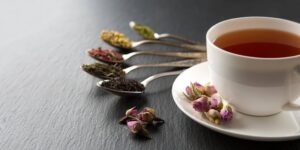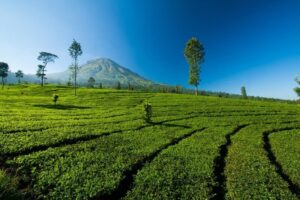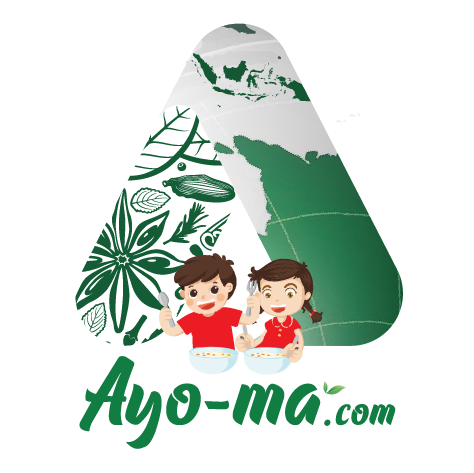Tea is a well-known natural beverage ingredient with a long history of popularity in
communities. Nowadays, tea products are available in both ready-to-drink and steep/brew
formats, with various innovations and creative presentations from different manufacturers.
Do you know that the colour, taste, and fragrance of each tea you consume can vary
significantly? These distinctions occur due to the differences in processing methods, plant
species, cultivation regions, brewing techniques, and composition.

Through this article, Ayoma would like to explore 4 well-known varieties of tea in Indonesia:
1. Black Tea
Black tea is one of the most commonly encountered types of tea. It’s also the most extensively
produced and exported tea in Indonesia, which ranks as the fifth-largest black tea exporting
country in the world
The production of black tea involves an enzymatic fermentation process that doesn’t rely on
microbes. This process utilises phenolase enzymes naturally present in the tea leaves, leading
to the oxidation of catechins into antioxidant compounds known as theaflavins and
thearubigin.
The resulting black tea typically has dark leaves and emits a robust tea aroma. When brewed,
it takes on a reddish to blackish-red hue with a flavour profile that tends to be slightly sour or
bitter, accompanied by its distinctive tea aroma.
2. Green Tea
Green tea is processed without undergoing a fermentation process. Instead, it activates the
folase enzyme naturally present in freshly harvested tea leaves by subjecting them to heat.
This heating process can be achieved through air-drying (roasting or baking) or by using hot
steam.
The choice of heating process imparts distinct aromas and flavors to the tea. Heating with hot
steam results in a lighter green color and a milder taste and aroma. Conversely, the oven or
roasting method yields a darker color and a flavor profile that tends to be smoky and creamy
in both taste and aroma.
3. Oolong Tea
The process of making oolong tea is categorized as semi-fermented, as it undergoes a
fermentation process but is halted as soon as possible through heating after the leaf-rolling
process. Additionally, oolong tea is distinct because it uses a different variety of tea compared
to other types, namely Camellia sinensis variety Sinensis, which imparts a lighter taste and
aroma. This tea, originating from China, may not be as popular as other varieties in Indonesia
due to its relatively limited production.
Oolong tea leaves are typically black in color with a lumpy-round shape. They offer a taste and
aroma that is lighter than black tea but more concentrated than green tea, featuring the
distinctive-mild flavors and aromas characteristic of oolong tea.
4. White Tea / Silver Needle
White tea is considered one of the premium types of tea in Indonesia. It does not undergo any
fermentation process; instead, it is immediately subjected to heat through evaporation or air
drying after harvesting. This tea gets its name from the young leaf buds that are covered in
fine white hairs. Due to its minimal processing, white tea leaves contain a higher content of
catechin antioxidant compounds compared to other types of tea, resulting in its superior
efficacy.
White tea is cultivated in various plantations across Indonesia, including the Ciwidey Tea
Plantation, the PTPN VIII Tea Plantation in Garut, and the PTPN XII Plantation in Wonosari, East
Java.
White tea leaves appear brownish-white and exude a distinctive tea aroma. When brewed,
white tea offers a very mild and slightly cloudy taste and aroma.
In addition, there are several provinces that produce the most tea in Indonesia, namely:
1. West Java (accounts for about 70% of national tea production)
2. Central Java
3. North Sumatra
With the abundant variety of teas in Indonesia, the potential for growth is vast. Unfortunately,
the teas most popular among the public are often limited to packaged tea beverages that
emphasize sweetness and artificial flavours. In addition to ready-to-drink teas, foreign teabags
and bobbas also dominate the market. Yet, there are numerous tea plantations with superior
products, such as Toba Wangi, Bukit Sari, Harendong, and Liki. Notably, tea products from the
Pasir Canar tea plantation even secured a gold medal at the Golden Leaf 2022 competition.

Hopefully, in the future, tea plantation products from Indonesia will receive greater
recognition and appreciation from both local and global audiences.
Visit our website for a collection of nutritious and captivating recipes using tea.
References:
https://indonesia.go.id/kategori/kuliner/283/mencecap-nikmat-dan-harum-tehindonesia?lang=1
https://www.merdeka.com/jatim/jenis-minuman-teh-paling-populer-dan-kaya-manfaatkesehatan-kln.html
https://www.indonesia-investments.com/id/bisnis/komoditas/teh/item240
In addition, there are several provinces that produce the most tea in Indonesi









No comments yet.